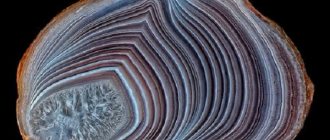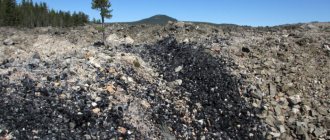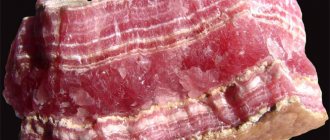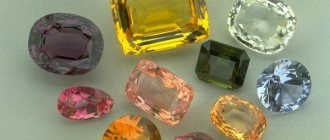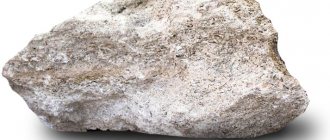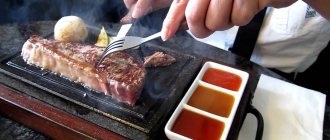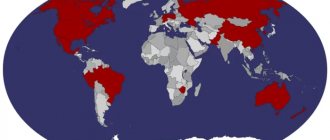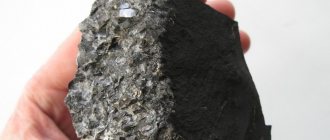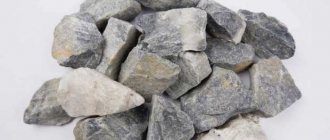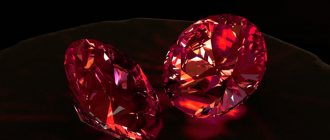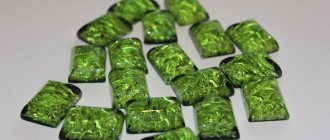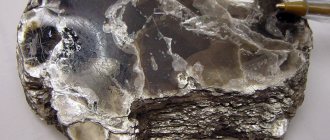Skarn Stone
Skarn is a generalized name for rocks of contact-metasomatic origin, which are dominated by silicates of iron, calcium, magnesium and manganese. The name is of Swedish origin and translates as “garbage”, “dirt”.
The stone is also called tactite, gornfels and seaside malachite. In Primorye, skarn occupies a place of honor in local folklore; paintings from it, due to its unique texture, carry a patriotic meaning (the cut of the stone reveals landscapes of Russian nature).
Depending on the composition of skarns and their origin, the color can vary in green, gray-green, white, brown and brown-pink shades. The texture of the stone is heterogeneous and can combine stripes and spots painted in different colors. Skarns are opaque, have low density, and are easy to cut and polish. The rock occurs in the form of veins, columnar crystals, lenses, layers and formations of irregular shape.
Varieties of mineral
Based on their chemical and mineralogical properties, skarns are divided into two types:
- Magnesian. Contain minerals rich in magnesium - spinel, dolomite, diopside or forsterite. Less common in the rock are orthite and sphene. In deposits with high iron content, forsterite is replaced by olivine. Deposits are formed at great depths or during the intrusion of magma into dolomites.
- Calcareous. They contain minerals of a granular or crystalline structure with a predominance of calcium - pyroxenes and calcium garnets adjacent to hematites and magnetites. Minor minerals in limestone deposits of skarns can be rhodonites, chalcopyrites, galenas and sphalerites. They are formed at surface or middle depths in the interaction of limestones with rocks of the aluminosilicate group.
Production
In Russia, the largest skarn deposits are located in the Primorsky Territory in the Far East. There are deposits in the Caucasus, the Urals and Karelia.
There are known mining sites in the world in Romania, the Czech Republic, Norway, Australia, Turkey, Bolivia, Indonesia and some other countries. As a rule, skarns are formed when magma reaches the surface, so they are mined by open-pit mining.
Skarns, the formation of which occurs at a considerable depth - up to 10 kilometers, remain unattainable for people; people are not yet able to lift them to the surface of the earth.
Mineral deposits
Raw skarn
Almost always, skarns in the rock are formed in the vicinity of valuable minerals, so the feasibility of developing deposits is determined based on the quality, quantity and usefulness of the minerals.
Skarn deposits are of global importance. The most significant of them is the Dalnegorskoye field, located in the Primorsky Territory of Russia. It contains skarn deposits rich in zinc and lead ores, as well as inclusions of sphalerites and galenas. Also in Russia, rich stone deposits are formed in the eastern regions of Siberia, Karelia, the Urals and the Caucasus.
In Europe, skarns are mined in Norway, Sweden, Romania, Czech Republic, Bulgaria, and France. Deposits of the mineral embedded in rock containing gold are being developed in Mexico, Brazil and Korea. Stone mining in deposits with copper and tungsten is carried out in Kazakhstan, Turkey, Indonesia, Australia, Bolivia, Afghanistan, Argentina and the states of North America.
Description of the stone
Skarn stone is a rock of igneous origin. It is formed as a result of natural replacement, when hot magma splashes out from the crater of a volcano and melts minerals encountered along the way.
Skarn translates from Swedish as "scum" and "dirt". This is due to the fact that during an eruption it is thrown out of the vent along with pumice and other rocks.
The stone is classified as ornamental. It consists mostly of silicates of calcium, magnesium, manganese, iron and a number of impurities.
Skarn is a fairly soft breed. Easy to polish, grind and cut. Density varies between 2.5–3.4 g per cubic meter. cm, and the hardness is 4–7 on the Mohs scale. At the same time, limestone rocks are much softer than magnesian rocks.
The stone has a gray tint, with stripes, spots and patterns of black, greenish, pink, white, and brown. Often multi-colored inclusions form natural motifs similar to mountains, forests, etc.
Skarn deposits are scattered throughout the world. The most famous in Russia is located in the Primorsky Territory (Primorsky malachite is skarn).
The stone is not popular among jewelers. It is mainly used to create decorative items (panels, figurines, eggs, cups, souvenir knives). It is used in costume jewelry to create beads, pendants, and jewelry framed in silver or jewelry alloys.
View this post on Instagram
Post from Minerals of Russia (@ross__minerali) Nov 26, 2021 at 6:30 PST
Magical properties of skarn
The magical properties of skarn are more versatile. He is a generator of positive energy, capable of accumulating positive human qualities and sharing them with the owner.
The stone does not tolerate haste, so long-term close contact is required for its effect to manifest itself.
To maximize the magical properties of esotericists, they recommend wearing a ring with a skarn. Depending on which finger it is worn on, the stone exhibits its properties:
- on the little finger - skarn develops the gift of persuasion and eloquence, the ability to smooth out conflict situations through negotiations;
- on the ring finger - the stone will become a talisman of love relationships and family ties;
- on the middle finger - the mineral will give its owner inner peace and harmony in relationships with others;
- on the index finger – the stone enhances ambition and thirst for power, so it is not recommended to wear it often on this finger;
- on the thumb - the gem will help its owner achieve cherished goals with minimal energy and material costs.
Scarn makes a person softer, kinder, brings harmony into his life, teaches mercy and compassion. It creates a favorable atmosphere for contact with other people, teaches spiritual values and caring for the environment.
Magnesian skarns
Mineral composition, structure and texture
The main minerals of magnesian skarns are forsterite, diopside, phlogopite, calcite, as well as apatite, hornblende, magnetite and tourmaline. In more ferruginous rocks, instead of pure forsterite, there is olivine containing a fayalite end-member, and instead of phlogopite, there is biotite.
Conditions of education and stay
They form zones, deposits, lenses, and vein bodies at the contact of granitoids with dolomites and dolomite marbles, or with igneous rocks of ultrabasic composition (dunites, harzburgites).
Application
A figurine of a bear made of skarn stone.
The unusual texture, combined with a large assortment of shades and flexibility in processing, make skarn in demand in crafts. The uses of skarn are varied. Souvenir balls, eggs, animal figures, candlesticks and vases are carved from stone. The patterns characteristic of the mineral in the form of mountain ranges or coniferous forests look impressive on wall panels and frescoes that are made from stone layers.
Scarn is not used in jewelry, but it makes beautiful jewelry. Bracelets, beads and pendants are cut from it. Cabochon-cut stones are set in silver or jewelry alloy and inserted into earrings and rings.
The stone is not used in industrial sectors, but in deposits in close proximity to it there are large deposits of ores rich in copper, molybdenum, zinc, tungsten, lead, iron, cobalt and gold.
Skarn stone. Description, properties and applications of skarn
Like dirt. As its name suggests, skarn stone is common and in little demand. From Swedish the word skarn is translated as “garbage”, “dirt”.
The breed itself is indeed not rare. But tungsten, molybdenum, iron, copper, cobalt and even gold ores are hidden in skarns.
It turns out that the skarn is like an unremarkable parent who gave the world great offspring.
But is the stone so useless and who exactly is it? We suggest you figure it out.
Description and properties of skarn
“Mineral skarn” is a wording with two errors. First of all, stone is not a mineral. This is a rock. The concept implies a stone composed of at least 2 minerals.
Actually, that’s what makes up skarns. The plural ending is due to the fact that the name of the rock is a collective name for a group of stones.
All of them are metasomatic, that is, they arose in contact with magma. But the composition of skarns varies. The basis of the stones is silicates of calcium, iron, manganese and magnesium.
Silicates of these elements are minerals that also make up skarnovites and hornfels. But, these breeds have 3 main components and more.
Skarns form exclusively duets, for example, garnet with pyroxene or wollastonite with hedenbergite. Other minerals are present only as impurities.
A large number of minor inclusions contain typically magnesian and transformed skarns.
These are two types of composition classification. Magnesium skarns contain spinel and forsterite as a base
There are also calcareous skarns . They contain calc-iron silicates.
Such stones are formed under water, at shallow depths. Apoaluminosilicate and autoreactive rocks remain.
The mineralogy of both types of skarns is silicate. Such skarns are the rarest, based on scapolite, which is also rare.
Skarns are united not only by their calcium-based silicate composition, but also by their structure.
It is granoblastic, that is, composed of isometric grains. This is what geologists call mineral elements developed in all directions.
Skarn is a stone whose properties vary depending on the composition and conditions of formation. Generally speaking, we can mention a density of 2.5 to 3.4 grams per cubic centimeter.
The hardness of the rock varies from 4 to 7 on the Mohs scale. The highest indicator is in magnesium varieties. Calcareous samples have the lowest hardness.
Many skarns are striped in color due to their layered texture. The lines are often wavy.
Due to this, in Primorye, for example, the breed became a raw material for products with patriotic themes.
The love for the ocean and proximity to it are also emphasized by the colors of the stone stripes. They are usually white and greenish.
For the abundance of the latter color, the stone was nicknamed Primorsky malachite. Officially, the name sounds like datolite skarn .
Applications of skarn
Skarns are generally easy to work with. Combined with the unusual texture, this makes the material attractive to craftsmen.
The breed is used for figurines, boxes, souvenir balls, flowerpots, and candlesticks. Scarns also fit into wall panels and frescoes.
Here, stones with characteristic patterns are used, which can resemble not only waves, but also coniferous forests and mountain ranges.
is also used in jewelry making . The photos show quite massive products.
Thin and miniature elements made from Primorsky malachite are fragile. In addition, the value of the stone is low.
You can use a whole block on the product without worrying that the decoration will not be accessible to everyone.
Skarn deposits provide raw materials for bracelets, beads, and earrings. Sometimes, stones reach jewelers, who frame them with silver and insert them into rings.
In terms of cutting, skarn is good in the form of cabochons. They have a smooth surface. Only this allows you to advantageously present the pattern of the breed.
There is no point in making it multifaceted. The skarn does not provide any play of light, and the drawing will be lost.
In industrial sectors, skarns are valued only as satellites of valuable ores. Therefore, it seems that they are actively looking for a waste breed.
In Russia, supplies are made from the Dalnegorskoye field. It is located in Primorye.
Local skarns are rich in zinc and lead. There are skarn deposits in the Urals, the Caucasus, and Karelia.
The European breed also comes to Norway, Romania, and the Czech Republic. The formation of skarns has also been observed in Australia, Bolivia, Turkey, and Indonesia.
Mining is also carried out in Argentina, Afghanistan, Kazakhstan, and France. It remains to be seen how this mining is carried out.
Mining skarn
Mining is carried out, as a rule, by open-pit mining from mountain slopes. They are the result of folding, the collision of lithospheric plates.
It is not surprising that it was precisely at the places where they joined that lava broke through to the surface, transforming the primary rocks.
There are also underwater mountains, but mining skarns here is not advisable. On the mainland, the iron ore rock formation is extracted from the Magnitnaya and Vysokaya rocks in the Urals and Sokolovskaya from the Sorbayskaya mountains in Kazakhstan.
The passage of molybdenum-tungsten skarn is carried out at Sandong, in South Korea and Tyrnyuz of the North Caucasus.
For polymetallic skarns, you need to contact the Chita region of Russia and Central Asia.
The boron-rich rock is mined in Kazakhstan, Central Asia, and South Korea. Of the Russian deposits, Primorye can be noted.
Copper skarns are extracted from the Ural subsoil and from a couple of deposits in Kazakhstan. But the gold ore went to Yakutia.
There are also lapis lazuli skarns. They are present in Afghanistan and Tajikistan. In Russia, lapis lazuli is hidden in the skarns of the Talovsky deposits of Slyudyanka, that is, the Baikal region.
Skarn price
Let's take pendants as an example of jewelry. Let's name the prices for pendants without a metal frame in order to understand the demands for pure stone.
Pendants weighing about 20 grams cost a little less than 400 rubles. For mineralogical collections, they sell polished sections with spectacular patterns.
For a cut 25 by 15 centimeters, 8 millimeters wide, they ask for approximately 5,000-7,000 rubles. The cost depends on the color of the stone and the beauty of the design on it.
Jewelry inserts are also sold. These are not finished decorations yet, but only the basis for them.
For cabochons measuring 5 by 3 centimeters, the width of which is less than 1 centimeter, they ask for somewhere between 200-270 rubles.
If the stripes on the stones are almost black and not green, they charge more - 300-400 rubles.
A souvenir egg about 6 centimeters high is estimated at 1,500-2,000 rubles. An ornamental ball can be purchased for less than 1,000.
The most expensive items made from skarn are paintings. They give tens of thousands of rubles for them.
The price tag depends on the complexity of the composition, the size of the stone mosaic, and the fame of the author of the panel.
So, even though skarns are like dirt, they are useful in making valuable things and are transformed in the hands of skilled craftsmen.
How to wear jewelry?
Anyone can wear products with skarn, regardless of gender and age. Women are recommended to use light-colored stones, while men tend to use dark-colored gems.
Jewelry with small skarn inserts is more suitable for young girls and women under 40 years old. Older ladies should pay attention to massive stones.
Scarn goes well with casual and business attire. In the latter case, jewelry with it will give its owner courage, openness and impressiveness.
Healing and magical properties of the mineral
Skarns do not have an extensive list of medicinal properties. They are used to eliminate headaches, relieve stress, and relax muscles and blood vessels.
The stone is considered the personification of positive energy. It makes its owner kinder, wiser, more sympathetic. Accumulates positive energy, helps to find harmony with yourself.
Scarn will teach you how to communicate with others and create favorable conditions for creating friendly relations. It will help you understand people, protect you from envious people and gossipers.
The stone amulet will begin to work only if worn for a long time. The properties will be enhanced by a silver frame.
Who does the stone suit according to their zodiac sign?
Astrologers advise people whose zodiac sign is protected by the elements of Fire and Water to pay attention to the mineral. Virgos, Taurus, Capricorns will learn to express their emotions, become more pleasant in communication, and more sensitive to other people's problems.
The stone will help Leos, Sagittarius, and Aries to realistically assess their goals, capabilities, and find compromises with others.
Price of products
Pendant with skarn
Jewelry, crafts made from skarn and collectible stones of small sizes have an affordable price:
- $2-5 – for pebbles ranging in size from 20 to 65 mm;
- $22-34 – for crafts in the form of animal figurines up to 100 mm high;
- $20 – for skarn beads 62 cm long;
- $26-38 – for a souvenir ball with a diameter of up to 55 mm;
- $37-42 - for a ring in a silver frame with a stone weighing from 6 to 12 grams;
- $75-82 - for earrings made of silver with a stone weighing from 9 to 18 grams.
Single large specimens of skarn and products made from it can be very expensive. For example, a bowl measuring 330x420x150 mm, made from solid skarn, the deposit of which is the Primorsky Territory of Russia, costs $1,350.
Areas of application and cost of products
Modern processing technologies and skillful hands can create miracles even from dirt, if that’s what this stone is called. A rainbow of colors, a variety of textures and structures, and ease of processing open up limitless scope for the imagination of jewelers and craftsmen who make souvenirs and interior decorations from natural materials.
As a result, we can see and purchase all kinds of figurines, jewelry, pyramids, balls, candlesticks, skarn boxes, in which the craftsmen only slightly changed the idea of nature and played with it at their own discretion.
Let us note that the Russian jewelry industry does not use skarn as a raw material; everything that we see and can buy is the result of the work of private craftsmen.
Skarn is a rather fragile stone, products made from it require careful handling. If due to carelessness they were damaged or broken, they can always be replaced with new ones, since their cost is low, due to the low price of the source material.
So, a pendant weighing 20 grams costs about 400 rubles. Polished sections with beautiful patterns, which are purchased for mineralogical collections, are valued higher. For example, a slice measuring 15x25 cm and 8 mm thick is sold for 5-7 thousand rubles.
Cabochons for jewelry measuring 5x3 cm and 1 cm wide cost 200-300 rubles.
Stones with black stripes are more expensive than those with green stripes - about 400 rubles. For small souvenirs they ask for 1-2 thousand rubles.
Paintings made from skarn are the most expensive; you will have to pay up to 30 thousand rubles for them, depending on the size and complexity of execution.
As a rule, inexpensive skarn in jewelry is framed in silver or jewelry steel; gold looks out of place here. Although this is quite consistent with the claims of occultists that silver has cleaner energy than gold.
When making jewelry, skarn is processed using the cabochon technique, this allows you to more fully reveal the beauty of the stone and present its patterns in the most favorable light.
For industry, skarns are of no value; they are sought only as satellites of more valuable ores, from which tungsten, zinc, lead, copper and even gold are extracted.
Skarns mined from Russian deposits were used to decorate Moscow metro stations; in particular, they can be seen at the Petrovsko-Razumovskaya station.
Stone care
To preserve the skarn in its original form, compliance with the minimum rules of care is required. It is not afraid of sunlight, moisture and high temperatures, but is poorly resistant to mechanical stress. Due to its average softness and low density, the stone cannot be subjected to falls or impacts. You should especially protect the gem from squeezing, as it can break into several pieces.
It is recommended to use a separate box for storing skarn. If this is not possible, then storing this stone along with other minerals is allowed only in a separate fabric bag.
If the stone becomes dirty, just wash it in soapy water or wipe it with a damp cloth.
Magnesian skarns. Features of formation and mineral parageneses.
Magnesian skarns are spinel-forsterite-clinopyroxene rocks with a large number of minor and accessory minerals. Some magnesian skarns are formed at the magmatic stage, while others are post-magmatic formations. Igneous-stage skarns are formed by the interaction of magnesian carbonate rocks with solutions that separate from the magma before its crystallization is complete or circulate in the host rocks at this time. The formation of skarns before the complete solidification of the magmatic melt is proven by the absence of endoskarns and the appearance of apophyses of unchanged igneous rocks crossing metasomatic rocks.
Source breeds. Magnesian skarns are formed from dolomites and magnesites. The MgO content in carbonate rocks sufficient for the formation of magnesian skarns is 12-13%. At the post-magmatic stage, magnesian skarns can also form on granites, granite-gneisses and migmatites, which are in contact with Mg-bearing carbonate rocks.
Conditions for the occurrence of metasomatic rocks . Magnesian skarns are found in two geological settings: 1) in deep granite-gneiss complexes of ancient shields; 2) near the contacts of granitoid intrusions, less often syenites, gabbroids and even ultrabasic rocks. Skarn formation is most complete in connection with granitoid magmatism. Magnesian skarns are formed at all depth levels, with the exception of near-surface ones. In abyssal conditions, they form sheet and lens-shaped bodies, the thickness of which reaches several hundred meters and a length of up to 1.0 – 1.5 km. Layered bodies are confined to dolomite horizons and lie in agreement with the host rocks. In the exocontact zones of intrusions, magnesium skarns occur in the form of steeply dipping pillars, tubular bodies, veins, and also form frontal deposits of bizarre shape.
The thickness of the bodies varies from tens of centimeters and a few meters to 100 m. Individual columnar bodies have been traced to a depth of up to 800 m.
Mineral composition. The main minerals of igneous-stage skarns are forsterite, spinel, clinopipoxenes (diopside or fassaite), calcite and, less commonly, dolomite. In deep conditions, enstatite and hypersthene are added to these minerals. At shallow depths, monticellite, merwinite and periclase appear, while forsterite and calcite disappear. Minor and accessory minerals in skarns are represented by magnetite, apatite, and in near-skarn rocks - sphene.
Magnesian skarns of the post-magmatic stage differ from skarns of the magmatic stage in the smaller amount of spinel, the greater role of calcite, and the increased iron content of non-ferrous minerals.
Chemical composition. Compared to the original carbonate rocks, the content of Al and Si increases in magnesian skarns of the magmatic stage, and the accumulation of Si is naturally associated with an increase in the intensity of metasomatism. Mg undergoes local redistribution, accumulating in forsterite skarns. In postmagmatic exoskarns, accumulation of Si and Fe occurs, partial removal of Mg and Ca with insignificant migration of alumina, and in endoskarns, on the contrary, accumulation of Mg and Ca occurs, with a decrease in the Si content.
Appearance. Forsterite and pyroxene skarns are green or dark greenish-gray; Calciphyres are a white rock. The structure of magnesian skarns varies from fine to coarse-grained. Fine-crystalline rocks have a hornfels appearance. The texture of skarns is massive, spotted, while calciphyres and forsterite skarns are banded, due to the chain arrangement of dark-colored minerals and spinel in the carbonate mass.
Stages and zoning of metasomatites . Magnesium scans are characterized by stable and clearly defined zoning.
0. Dolomite
1. Calcifir: Fo + Shp + Ka + Do
2. Spinel-forsterite skarn: Fo + Shp + Ka
3. Spinel-pyroxene skarn: Pi + Shp + Ka
4. Pyroxene-plagioclase rock: Pi + Pl
0. Aluminosilicate rock (granite, gneiss)
For moderate depths, columns of a slightly different type are characteristic:
0. Dolomite
1. Calcifir: Fo + Shp + Ka + Per
2. Forsterite skarn: Fo + Shp + Ka
3. Pyroxene skarn: Pi + Shp + Ka
0. Granite
The formation of skarn deposits is associated with the processes of calcium and magnesium metasomatism occurring at the contacts of acidic and moderately acidic granitoids (granites, granodiorites, syenites) with their host carbonate, less often silicate rocks. The optimal depth range is 500-2000 m. The temperatures of their formation, according to most researchers, vary widely - from 900 to 250 °C. The process develops in several stages, during which the aggregative state of the solutions changes - and from pneumatolytic they become typical hydrothermal.
Mineral formation in zones of sulfide deposits.
The healing effect of skarn
Meditation with the mineral helps restore your emotional background and helps you relax.
The mineral is often used in meditation sessions. The stone brings peace, promotes muscle relaxation, relaxation, positive energy comes from its homogeneous smooth structure, neutral appearance, lines diametrically enveloping the surface. Prolonged contemplation and touch are useful for restoring the emotional background in case of anxiety, excitement, stress; application to the temples is useful for relieving migraine attacks.
